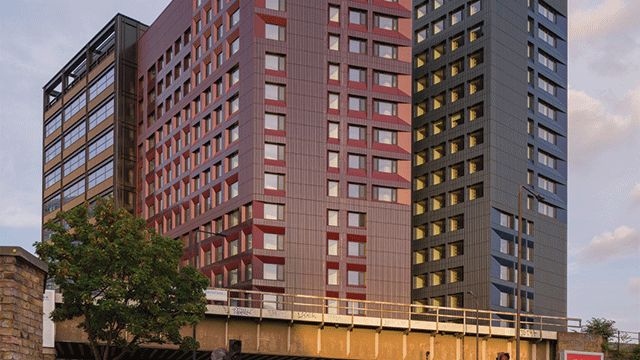Adam Miller and Thomas White reflect on a shift in the profile of lenders in the commercial real estate market and flag the pros and cons for those looking to make the leap.
The lines between different types of lenders in the real estate sector are beginning to blur. With new entrants to the market, what was previously firmly the domain of bridging lenders (at least post-Lehman) is now becoming more palatable to high street lenders.
This change is being driven by the appetite of borrowers and their professional advisers. The housing shortages and new policies brought in by successive governments have made it less attractive for investors to hold residential property, and a number are diversifying their portfolios. There is a need for lenders to offer products to enable borrowers to develop different types of property and generally to provide products to enable investors to purchase these units or develop then refinance them. Such investment falls generally in the region of £500,000 to £5m.
Advantages of new entrants
The institutional (often more risk-averse) lenders have recognised that this is an area where there is potentially a lot of money to be made through dealing with a new and different type of borrower. Furthermore, yields are generally good and the commercial marketplace hasn’t been affected in the same way as residential.
Bridging lenders that succeed in this market comprise teams who work closely with their borrowers and take time to understand what they are doing on a day-to-day basis. While high street lenders continue to have the bank manager/relationship manager who will keep in close contact with the borrower, a lot of their security functions tend to be centralised. This can be a source of frustration for both the solicitors who need to deal with those departments and the staff within the banks. Bridging lenders, however, tend not to have this obstacle – at least for the moment anyway. This means that a bridging lender is often quicker, more adaptable and creative in solving issues when they arise.
Institutional lenders increasingly diversifying can only be a good thing so far as the borrowers (developers and property traders) are concerned. It will increase competition and enable investors to consider commercial or mixed-use property. This will ultimately benefit both developers and property traders due to the increase in end users available, beyond just larger funds or property investment companies.
Patterns of investment
The type of property often involved in such deals is a freehold with commercial on the ground floor and residential uppers, although there is an increasing prevalence of commercial throughout. The latter are often on business parks with smaller commercial units – a trend set to continue if the pattern of larger retail and supermarket stores moving away from large out-of-town developments to smaller more local sites on the high street continues.
A further market trend is a rise in the number of long-leasehold commercial interests created, which were historically used to allow the developer to freely deal with the commercial element without recourse to any rights of first refusal for the residential uppers. These are now being used to allow investors to acquire a commercial interest in a floor of a building which is commercial only.
Institutional lenders are also increasingly diversifying the type of security against which they will lend in order to better service their entrepreneurial clients and, ultimately, not lose the business following a diversification of their borrower’s portfolio.
Furthermore, private individual investors, fortunate to have considerable wealth, are realising that they can invest directly in commercial property, rather than indirectly through an investment vehicle or fund. There are risks associated with this of course, but a number of investors do simply prefer to have a building or unit that they can call theirs. It is only natural that more and more investors will follow suit as they (and their advisers) see commercial property as less of a risk (or an unknown).
Once an investor understands what it means to have a commercial tenant, they will see the potential benefits. These often include a longer term, with potentially the ability to enforce an authorised guarantee agreement, and the deposit being held by the landlord, often simply in a separate account governed by a rent deposit deed that the parties are free to negotiate (in contrast with the more onerous deposit rules for residential property.
While a tenant’s right of security of tenure is potentially troublesome, investors will realise that this means in practice that the tenant wants to remain and continue to pay rent. If the tenant does not pay then the landlord can quite quickly take steps to forfeit. Additionally, and as long as the lease is sufficiently drafted, there will be rent reviews and the tenant pays, on top of their rent, service charges and other contributions.
A note of caution
There are, of course, risks. Recently restaurant chains in particular have reported difficult trading. In these conditions it is possible that an investor could find itself in the situation where it has a vacant commercial unit that is niche or bespoke and it may struggle to re-let it without capital investment. Surveyors and valuers are going to be key to the considerations here.
All these factors are combining to drive a diversification of the marketplace, so that lenders that previously would not have even considered commercial properties are adapting their offerings, and developers previously only interested in residential are moving into commercial property.
The difficulty in this transition, however, at least for the investor who simply wants a better return on their investment, will be the management of such units, which is quite different to residential. As such, it is likely that agents – who previously dealt with registration of deposits and signing up tenants to successive ASTs – will themselves diversify and offer services like rent review.
It is natural for the lending market to react to the requirements of the entrepreneurs and latterly the end user owners. As such, as the bridging market continues to move into the commercial sector, institutional lenders are likely to follow suit.
Adam Miller is head of the real estate finance team and Thomas White is associate in the commercial real estate team at Seddons








